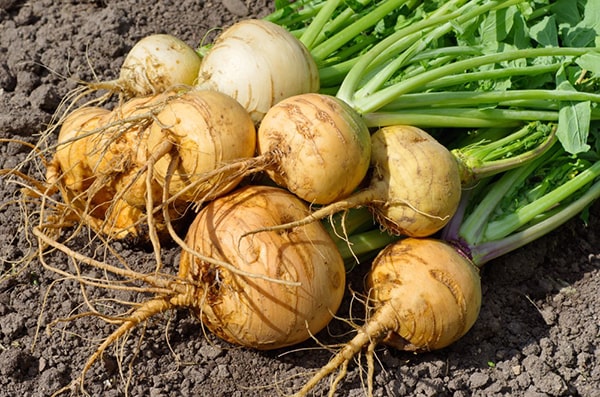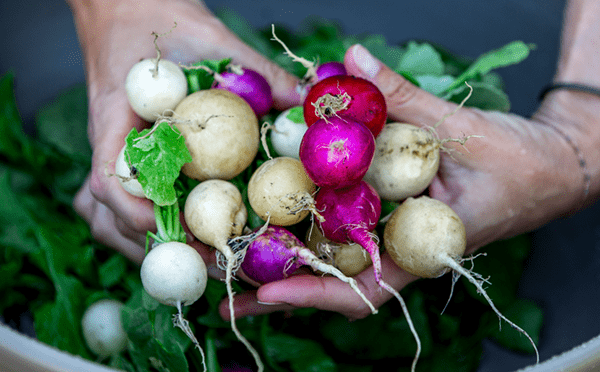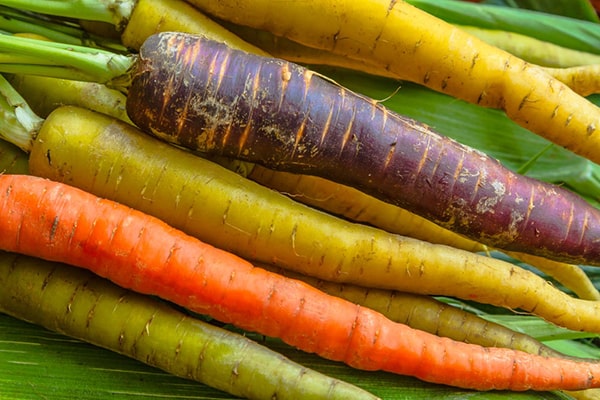Human eating patterns have varied greatly from location to location and throughout history, but there has always been one constant.
Until very recently, seasonal eating was the norm worldwide.
After all, without refrigeration and mass transport technology, there wasn’t much choice but to eat whatever was local and in season!
Returning to eating what’s in season is an easy, rewarding way to add some variety to your diet and find a new appreciation for the rhythms of nature.
Not only that, there may be significant payoffs in terms of health.
Fall begins with the autumnal equinox in the Northern Hemisphere. Along with shorter days and cooler nights, that means root vegetables are coming into season.
Keep reading to learn how root veggies can support your health and wellness this fall, 4 root veggies you need to try ASAP, tips to prepare and enjoy them, and the unique health benefits of each one.
What Exactly is Seasonal Eating?
Look to the seasons when choosing your cures. -Hippocrates
Due to the growing interest in traditional lifestyles, as well as environmental sustainability, more people are eating seasonally again in recent years.
This style of eating means fewer frozen or packaged foods, no processed foods, and educating yourself about what is growing in your area each season.
The easiest way to keep your diet seasonal is to shop as much as possible from your local farmer’s market. If you’re an omnivore you can still get animal products from the grocery store, though, because unlike plants, animals don’t come and go with the seasons.
On the other hand, you’ll find that the plant-based remainder of your diet will vary significantly from month to month.

Seasonal Eating Benefits
It’s no secret that buying locally helps the environment and your local economy, but it also turns out that foods grown and harvested in their natural season use fewer resources and may have more nutritional value (1).
And evolutionary biology suggests that the local environment provides the precise micronutrients, phytonutrients, and other plant compounds that are most suitable for our bodies during any given season (2).
For example, vitamin D levels are naturally highest in summer, and having sufficient vitamin D helps support healthy blood sugar levels (3).
Not coincidentally, summer is also the time when photosynthesis allows plants to produce the most sugary, carb-rich fruits due to high levels of ultraviolet (UV) light.
The takeaway? High-glycemic-index carbs are less of a problem in summer, but eating less sugar is wise in fall and winter.
It also turns out that changes in sunlight, day length, and temperature can affect your microbiome throughout the year.
According to recent research, eating local and seasonal foods can sync your gut bacteria up with these natural cycles (4)(5).
And that can lead to a more diverse and robust microbiome, which studies link to supported mental health and digestion, and greater overall vitality (6)(7).
More Roots, Fewer Grains?
This autumn, consider replacing grains and processed foods with a healthier, seasonally appropriate carb source: starchy root vegetables.
In light of the history of human evolution, grains are a relatively recent addition to our diet. Some scientists argue that we haven’t had time to properly adapt to them (8).
Anti-nutrients, harmful compounds found in wheat and other grains, may compromise your gastrointestinal tract and aggravate inflammation in your body (9)(10).
On the other hand, humans and other primates have always eaten tubers, and sensitivities to these root vegetables are far less common than wheat or grain sensitivities. (11)(12)(13).
Worried that you’ll miss out on fiber by ditching grains?
While it’s true that whole grains are one way to get dietary fiber, root vegetables also have a high fiber content.
Not only that, root veggies tend to have a lower glycemic index (a measure of how quickly your blood sugar levels rise), and a greater amount of micronutrients and other beneficial compounds compared to an equivalent serving of grains.
For example, a slice of whole-grain bread has a glycemic index of 74, while a boiled sweet potato has a GI of 44.
Eating low-GI foods can help promote healthy blood sugar levels, support your body’s anti-inflammatory response, and may even help with healthy weight management (14)(15)(16).
Whether or not you care about a gluten-free or grain-free diet plan, if you want to make your diet healthier this fall without jumping on the keto or low-carb bandwagons, these suggestions will be perfect for you!
4 Must-Try Root Vegetables for Autumn
#1: Turnips
Turnips are a white, fleshy root vegetable.
They may have been domesticated as early as the 15th century BCE, and have been a nutritious staple food ever since.
A 100-gram servings of turnips has:
- 130 calories
- 30 grams of carbs
- 7 grams of dietary fiber
- 1.5 grams of protein
- 0.3 grams of fat
They’re a cool-season crop that does best between 40 and 60 degrees Fahrenheit, so in most of North America, they’re harvested in September, October, and November.

Benefits of Eating Turnips
Turnips are a cruciferous vegetable, meaning they’re in the same family as broccoli, cauliflower, Brussels sprouts, and kale.
Like other cruciferous vegetables, turnips are full of compounds that support your body’s natural anti-inflammatory response and overall health (17)(18)(19)(20).
They’re also loaded with fiber, as well as micronutrients like vitamin C, manganese, and potassium.
Tips for Cooking Turnips
You can enjoy turnips raw, roasted, boiled, or even mashed.
Slice them, dice them, or leave them whole–it all depends on the size of the turnip and how you plan to serve it.
Peeling turnips is optional, but if you notice spots or yellowed areas, make sure to remove those before you cook them.
Some people enjoy the mildly bitter taste of large, mature turnips, but if you want to mellow them out, try boiling them in salty water and serving them with a raw-cheese- or grass-fed heavy-cream-based sauce.
And if you purchase whole turnips at your local farmer’s market, don’t forget to boil or saute the leafy greens to serve up as a nutritious dish on the side, too.
#2: Burdock Root
Burdock root, a member of the genus Arctium, is native to Europe and Asia, but now grows in the United States too.
The roots of the Burdock plant grow deep underground. They’re long, dark brown or nearly black on the outside, with creamy white flesh that tastes similar to artichoke hearts: rich and earthy.
A 100-gram serving of Burdock root offers:
- 90 calories
- 21 grams of carbohydrates
- 2 grams of fiber
- 2 grams of protein
- 0.1 grams of fat
Burdock plants grow year-round, but the best harvest time for the roots is in late fall. Look for Burdock roots in October, November, and early December.

Benefits of Eating Burdock Root
Burdock root contains respectable amounts of vitamin B6, potassium, magnesium, and manganese.
Scientific studies have recently confirmed some of the centuries-old folk uses of Burdock. Evidence suggests it may support healthy blood and circulation, promote healthy skin, and support the body’s natural anti-inflammatory response (21)(22)(23).
Other research indicates Arctium species like Burdock are high in the superstar antioxidants quercetin and luteolin, which may help explain some of their health benefits (24).
Tips for Cooking Burdock Root
You can peel it if you want, but most of the flavor–and many of the beneficial phytonutrients–occur in the skin of Burdock root.
Try sauteeing Burdock root over medium heat with your preferred cooking oil (avocado oil, coconut oil, or grapeseed oil all work well).
It should take about five minutes to lightly brown, then you can add soy sauce and your favorite herbs.
Simmer for another five minutes until it’s cooked through but still crispy, then enjoy it hot.
#3: Radishes
The radish is an edible root veggie that was first domesticated in pre-Roman Europe. It’s now grown worldwide.
Radishes have a pleasant peppery flavor, similar to horseradish (but much milder).
A 100-gram serving of radishes has:
- 16 calories
- 3.5 grams of carbs
- 1.6 grams of dietary fiber
- 0.7 grams of protein
- 0.1 grams of fat
This root veggie grows well during fall or winter, and matures in as little as 20 days, so even if you aren’t an experienced gardener, it’s a fantastic choice to grow at home.

Benefits of Eating Radishes
Like turnips, radishes are a cruciferous vegetable, so they’re a great option if you want to promote overall health (and who doesn’t, really?).
Tips for Eating Radishes
If you’ve never tried radishes before, try adding thin-sliced radishes to a greens salad with extra-virgin olive oil and apple cider vinegar.
This root vegetable also makes an excellent, crunchy snack when raw: just rinse and pop them in your mouth.
Radishes are most nutritious when eaten fresh, but they’re also excellent pickled, fermented, or as an ingredient in braised beef or a hearty stew.
#4: Heirloom Carrots
Everyone knows about carrots. They’re the crunchy, orange root vegetable your mom packed in your lunchbox.
Okay, but have you tried heirloom carrots?
Heirloom vegetables are are old-time varieties of veggies, carefully pollinated rather than hybridized, and often handed down through many generations of farming families.
Unlike the orange mass-produced grocery store variety to which you may be accustomed, heirloom carrots come in colors including white, dark red, and purple, with amazing flavor profiles to match.
Two medium carrots weighing approximately 100 grams contain:
- 40 calories
- 9.5 grams of carbs
- 3 grams of fiber
- 1 gram of protein
- 0.2 grams of fat

Benefits of Eating Heirloom Carrots
Carrots are a great source of vitamin K, vitamin C, vitamin B6, and manganese.
And they’re an outstanding way to obtain a whopping 16,000 IU of vitamin A per serving, which is over 300% of your recommended daily allowance (RDA).
However, heirloom carrots have even more benefits thanks to their unique free radical-quenching antioxidants and anthocyanins.
Research suggests that purple root veggies, which includes some heirloom carrots, can benefit your gut health, and may even support your body’s natural anti-inflammatory response (25)(26).
Tips for Enjoying Heirloom Carrots
Cooking carrots makes the beta-carotene more bioavailable for digestion, but reduces heat-sensitive nutrients like vitamin C and folate.
For optimal flavor, enjoyment, and nutrition, always enjoy carrots raw first. Munch them raw or add them to salads: simple enough, right?
If you are lucky enough to find a big bushel of heirloom carrots, you can add the leftovers to stir fries, stews, or soups.
Final Thoughts
Root veggies are one of the easiest, tastiest ways to achieve a more balanced diet.
This fall, try seasonal eating for better health, a greater appreciation of your environment, and more authentic alignment with mother nature.
Did we include your favorite root vegetable? Would you like to share a time-tested recipe? Please let us know in the comments below!






